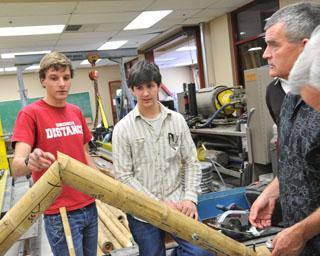
Heads, hearts and hands at work for Haiti
Three civil engineering senior design teams are helping Haiti rebuild stronger and more affordable homes. Students Jake Echeverria and Chris Sampson have researched and tested new material and building techniques developed in conjunction with EBNet (Ecological Building Network), a group of architects and engineers in the Bay Area who are volunteering their skills to create model homes using sustainable building materials to help in the reconstruction of Haiti. Their method puts bamboo poles filled with mortar made from earthquake rubble into braced frame and truss systems, creating a structure sound enough to withstand future earthquakes and hurricanes. A special rebar dowel protected by a soda-pop bottle top provides ductility needed to resist seismic actions while protecting the bamboo frame connections from overstress. The bamboo framed seismic-resisting system is intended to stimulate a local bamboo forestry industry while maintaining affordable construction.
Meanwhile, seniors Maura Cyrus, Nicholas deCesare, and Alvaro Lacayo have designed and tested a new concrete block incorporating recycled rubble from the 2010 earthquake to create a product that is designed for its intended use as a weather barrier, partition, and form. The low strength requirements allow a much leaner cement paste to be used, thereby reducing the embodied energy and greenhouse gas emissions associated with Portland cement. The lower cement content and use of recycled materials also makes the block much more affordable than what had customarily been available. Tested successfully earlier this year, the team’s blocks will also be put to good use for rebuilding by EBNet in conjunction with their fellow Broncos’ bamboo poles.
In building their 500-square-foot house, the third team—Danielle Locklar, Kelli Oura, and Lauren Reinnoldt—collaborated with Well Bilt International, Sureboard USA, Necessity Housing, and California Expanded Metal Company. Their home was developed and built from modular structural foam and sheet steel panels, making it lightweight but stronger than anything previously used in Haiti. The structure is designed to withstand regional earthquakes and winds up to 150 miles per hour, and includes a system to collect and filter rain water so residents need not leave home to find clean water.
Knowing that hiring skilled workers to build a home properly generally costs more than Haitians can afford, the students are creating a kit with color-coded, pre-cut, pre-drilled panels so residents can assemble the home themselves using easy-to-follow instructions. The trio demonstrated the ease of their design by assembling an 8-square-foot prototype in just under three hours.
“The goal for the project,” said team advisor and Associate Professor Reynaud Serrette, “was to provide housing that is easily assembled, creates in-country industry for fabrication, and stimulates trade between countries in the Caribbean and Mexico that already provide cold-formed steel.”
“It’s gratifying to see our students’ work put to such good use in the world,” said civil engineering chair Mark Aschheim. “With their focus on collaborative, ethical, sustainable building for people in need, these students exemplify the type of ‘engineering with a mission’ we strive for at Santa Clara.
Learn more:
http://www.ecobuildnetwork.org/
http://www.wellbiltinternational.com/
http://www.necessityhousing.com/